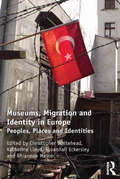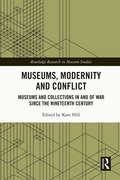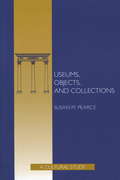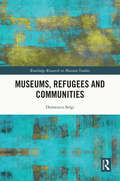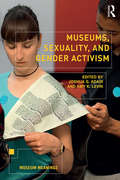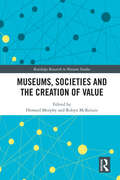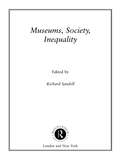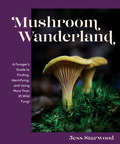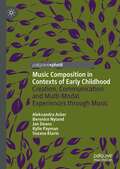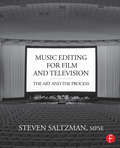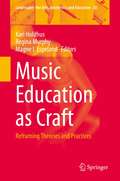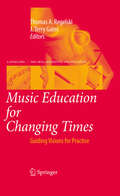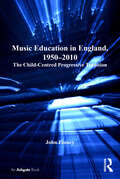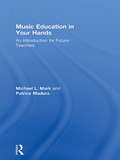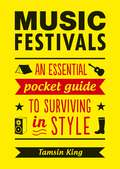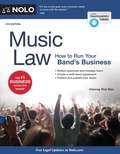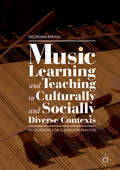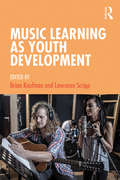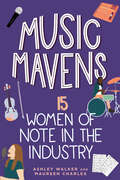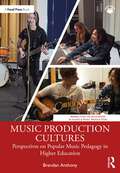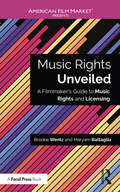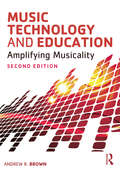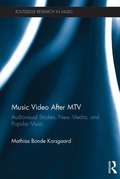- Table View
- List View
Museums, Migration and Identity in Europe: Peoples, Places and Identities
by Rhiannon Mason Christopher Whitehead Susannah Eckersley Katherine LloydThe imperatives surrounding museum representations of place have shifted from the late eighteenth century to today. The political significance of place itself has changed and continues to change at all scales, from local, civic, regional to national and supranational. At the same time, changes in population flows, migration patterns and demographic movement now underscore both cultural and political practice, be it in the accommodation of ’diversity’ in cultural and social policy, scholarly explorations of hybridity or in state immigration controls. This book investigates the historical and contemporary relationships between museums, places and identities. It brings together contributions from international scholars, academics, practitioners from museums and public institutions, policymakers, and representatives of associations and migrant communities to explore all these issues.
Museums, Modernity and Conflict: Museums and Collections in and of War since the Nineteenth Century (Routledge Research in Museum Studies)
by Kate HillMuseums, Modernity and Conflict examines the history of the relationship between museums, collections and war, revealing how museums have responded to and been shaped by war and conflicts of various sorts. Written by a mixture of museum professionals and academics and ranging across Europe, North America and the Middle East, this book examines the many ways in which museums were affected by major conflicts such as the World Wars, considers how and why they attempted to contribute to the war effort, analyses how wartime collecting shaped the nature of the objects held by a variety of museums, and demonstrates how museums of war and of the military came into existence during this period. Closely focused around conflicts which had the most wide-ranging impact on museums, this collection includes reflections on museums such as the Louvre, the Stedelijk in the Netherlands, the Canadian War Museum and the State Art Collections Dresden. Museums, Modernity and Conflict will be of interest to academics and students worldwide, particularly those engaged in the study of museums, war and history. Showing how the past continues to shape contemporary museum work in a variety of different and sometimes unexpected ways, the book will also be of interest to museum practitioners.
Museums, Objects, and Collections: A Cultural Study
by Susan PearceThis book examines the historical context of museums, their collections, and the objects that form them. Susan M. Pearce probes the psychological and social reasons that people collect and identifies three modes of collecting: collecting as souvenirs, as fetishes, and as systematic assemblages. She considers how museum professionals set policies of collection management; acquire, study, and exhibit objects; and make meaning of the objects in their care. Pearce also explores the ideological relationship between museums and their collections and the intellectual and social relationships of museums to the public.
Museums, Refugees and Communities (Routledge Research in Museum Studies)
by Domenico SergiMuseums, Refugees and Communities explores the ways in which museums in Germany, The Netherlands and the UK have responded to the complexities and ethical dilemmas involved in discussing the reasons for, and issues surrounding, contemporary refugee displacements. Building upon an ethnographic study carried out in the UK with refugees from the Democratic Republic of Congo, the book explores how object-led approaches can inspire new ways of thinking about and analysing refugees’ experiences and European museums’ work with their communities. Enlarging the developing body of research on museums’ increasing engagement with human rights and focusing in particular on the social, cultural and practical dimensions of community engagement practices with refugees, the book also aims to inform growing debates on museums as sites of activism. Museums, Refugees and Communities offers an innovative and interdisciplinary examination of museum work with and about refugees. As such, it should appeal to researchers, academics and students engaged in the study of museums, heritage, migration, ethics, community engagement, culture, sociology and anthropology.
Museums, Sexuality, and Gender Activism (Museum Meanings)
by Amy K. Levin Joshua G. AdairMuseums, Sexuality, and Gender Activism examines the role of exhibitionary institutions in representing LGBTQ+ people, cisgender women, and nonbinary individuals. Considering recent gender and sexuality-related developments through a critical lens, the volume contributes significantly to the growing body of activist writing on this topic. Building on Gender, Sexuality and Museums and featuring work from established voices, as well as newcomers, this volume offers risky and exciting articles from around the world. Chapters cover diverse topics, including transgender representation, erasure, and activism; two-spirit people, indigeneity, and museums; third genders; gender and sexuality in heritage sites and historic homes; temporary exhibitions on gender and sexuality; museum representations of HIV/AIDS; interventions to increase queer visibility and inclusion in galleries; LGBTQ+ staff alliances; and museums, gender ambiguity, and the disruption of binaries. Several chapters focus on areas outside the US and Europe, while others explore central topics through the perspectives of racial and ethnic minorities. Containing contributions that engage in sustained critique of current policies, theory, and practice, Museums, Sexuality, and Gender Activism is essential reading for those studying museums, women and gender, sexuality, culture, history, heritage, art, media, and anthropology. The book will also spark interest among museum practitioners, public archivists, and scholars researching related topics.
Museums, Societies and the Creation of Value (Routledge Research in Museum Studies)
by Howard Morphy Robyn McKenzieMuseums, Societies and the Creation of Value focuses on the ways in which museums and the use of their collections have contributed to, and continue to be engaged with, value creation processes. Including chapters from many of the leading figures in museum anthropology, as well as from outstanding early-career researchers, this volume presents a diverse range of international case studies that bridge the gap between theory and practice. It demonstrates that ethnographic collections and the museums that hold and curate them have played a central role in the value creation processes that have changed attitudes to cultural differences. The essays engage richly with many of the important issues of contemporary museum discourse and practice. They show how collections exist at the ever-changing point of articulation between the source communities and the people and cultures of the museum and challenge presentist critiques of museums that position them as locked into the time that they emerged. Museums, Societies and the Creation of Value provides examples of the productive outcomes of collaborative work and relationships, showing how they can be mutually beneficial. The book will be of great interest to researchers and students engaged in the study of museums and heritage, anthropology, culture, Indigenous peoples, postcolonialism, history and sociology. It will also be of interest to museum professionals.
Museums, Society, Inequality (Museum Meanings)
by Richard SandellMuseums, Society, Inequality explores the wide-ranging social roles and responsibilities of the museum. It brings together international perspectives to stimulate critical debate, inform the work of practitioners and policy makers, and to advance recognition of the purpose, responsibilities and value to society of museums. Museums, Society, Inequality examines the issues and: offers different understandings of the social agency of the museum presents ways in which museums have sought to engage with social concerns, and instigate social change imagines how museums might become more useful to society in future. This book is essential for all museum academics, practitioners and students.
Mushroom Wanderland: A Forager's Guide To Finding, Identifying, And Using 25 Wild Fungi
by Jess StarwoodThe breathtaking beauty of mushrooms from a master forager: how to identify and use them in cooking, home remedies, and spirituality. Foraging for mushrooms is a meditative and rewarding escape. Even if readers aren’t ready to head out into the woods, this enchanting visual guide is a welcome introduction to 25 easily identifiable species, organized by location and use. Author Jess Starwood has led hundreds of foraging trips, sharing her knowledge of nature with students. This, her first book, is a celebration of fungi—perfect for both beginner and longtime mushroom admirers. No matter their use, all mushrooms have specific characteristics that are easy to recognize with the right teacher. Under Starwood’s guidance, readers will learn to identify caps, stipes, gills, and pores. They’ll encounter species such as Reishi, Lion’s Mane, Candy Cap, Chanterelle, and more; learn the best harvesting seasons; and enjoy delicious recipes using culinary favorites. But, above all, this guide will have readers growing their connection to nature and dreaming of the wonderful world of fungi.
Music Composition in Contexts of Early Childhood: Creation, Communication and Multi-Modal Experiences through Music
by Jan Deans Berenice Nyland Aleksandra Acker Kylie Payman Suzana KlarinThis book explores the narratives of a group of four-year-old children in a composition project in an Australian early learning centre. The participants, centre staff and a composer, Stephen Leek, contributed a number of music sessions for the children, including five original songs. The book showcases young children’s communicative ability and sensitivity to wider issues. The staff in the centre have a strongly voiced philosophy that is enacted through arts-based pedagogy and incorporates significant themes including a respect for Aboriginal culture and custodial responsibility towards a sustainable future for the earth. Examples of adult and children’s ideas are illustrated through music making, singing, dancing, words, drawings and paintings, which provide insights into a world where children are viewed as active citizens and the arts have rights. The book describes the context of the centre, the history of projects and details one project as an example of “lifeworthy learning”.
Music Editing for Film and Television: The Art and the Process
by Steven SaltzmanMaking music for the movies is a complicated, involved, and challenging process. Music Editing for Film and Television covers the practical skills needed to successfully hone your craft. Through an overview of the music editing process, this book will equip you with detailed techniques to solve musical problems encountered during editing. An abundance of interviews with well-known professionals provide a wide range of perspectives on music editing for film, while special features address an array of projects, from a low-budget documentary, to a Hollywood blockbuster, to indie projects.
Music Education as Craft: Reframing Theories and Practices (Landscapes: the Arts, Aesthetics, and Education #30)
by Regina Murphy Kari Holdhus Magne I. EspelandThis book is a collection of leading international authors in the field of music education taking the concept of 'craft' as a starting point to deconstruct and reconstruct their understanding of the practices and theories of music education. Their insights draw from deep wells of resources located in historical, philosophical, epistemological, musicological and educational traditions that lead to rich and complex insights on the evolving field of music education. In so doing, they generate a constellation of new understandings and illustrations of what crafts can mean in this field. Historically, the idea of craft was typically associated with a skill or experience in knowing how to do or make something, or an activity of some kind that requires specific professional skills. In Old Norse, the concept for craft was kraptr, meaning strength and virtue, while Old English and continental use was associated with power and physical strength, as well as skill. When these definitions of ‘crafts’ are infused into contemporary understandings of the field of music education as a professional field, a whole new set of possible interpretations are unearthed. Such insights are not exhaustive, but rather, point the way in which this professional, diverse, inclusive and ambiguous field might continue to evolve in the 21st century.
Music Education for Changing Times
by J. Terry Gates Thomas A. RegelskiBased on topics that frame the debate about the future of professional music education, this book explores the issues that music teachers must confront in a rapidly shifting educational landscape. The book aims to challenge thought and change minds. It presents a star cast of internationally prominent thinkers in and beyond music education. These thinkers deliberately challenge many time-worn traditions in music education with regard to musicianship, culture and society, leadership, institutions, interdisciplinarity, research and theory, and curriculum. This is the first book to confront these issues in this way. This unique book has emerged from fifteen years of international dialog by The MayDay Group, an organization of more than 250 music educators from over 20 countries who meet yearly to confront issues in music teaching and learning.
Music Education in England, 1950-2010: The Child-Centred Progressive Tradition
by John FinneyJohn Finney examines the child-centred progressive tradition to create a fresh way of evaluating ideas and practices that have evolved since 1950, that have shaped the lives of music teachers and their pupils, and that have now become disfigured, residual and altogether lost in the light of social, cultural and political change. The book is a critique of the present situation with an intention to expose the dangers in our current pursuit of future gains that are thought to serve the making and sustaining of the social order. The project draws in major debates of the period, along with their protagonists, counter-pointed by the voices of teachers and pupils. At the same time, the structuring voices of policy and governance become ever louder as we reach the present time. Finney presents a compelling, analytical account through a series of six episodes, each seeking to capture the spirit and fervour characteristic of a particular phase within the period studied. In the concluding chapter the narrative developed is reviewed. From this the idea of music education as an ethical pursuit is proposed. Finney argues that classroom relationships can be thought of as playfully dialogic, where teacher and pupil remain curious, and where there is serious attention to what is to be taught and why. This will always need to be negotiated, with the expressed and inferred needs of children working together to find a critical approach to what is being learnt. Finney's book provides fresh inspiration for practitioners and new challenges for researchers, and as such is a landmark in the field of arts and music education.
Music Education in Your Hands: An Introduction for Future Teachers
by Michael L. Mark Patrice MaduraMusic Education in Your Hands is a textbook for the introductory course in Music Education. Written for future classroom music teachers, the book provides an overview of the music education system , illuminating the many topics that music educators need to know, including technology, teaching methods, curricular evolution, legislation, and a range of societal needs from cultural diversity to evolving tastes in music. It encompasses a broad picture of the profession, and how the future of music education rests in the hands of today’s student teachers as they learn how to become advocates for music in our schools. FEATURES A balance of sound historical foundations with recent research and thinking; Coursework that is appropriate in level and length for a one semester introductory course; Actual dialogue between undergraduate music education majors and teachers, illustrating pertinent issues teachers must face; An emphasis on opportunities in the greater community beyond the walls of the school that music teachers should be familiar with; Suggested topics for activities and critical thinking for every chapter; A companion web site including student and instructor resources
Music Education, Ecopolitical Professionalism, and Public Pedagogy: Towards Systems Transformation (SpringerBriefs in Education)
by Margaret S. Barrett Heidi M. WesterlundThis book challenges the dominant expertise professionalism rationale for music education by responding to the call to develop ‘ecological awareness’ at a time when all professions have a moral obligation to place sustainable and interdependent life at the center. The book aims to expand music education’s professional horizons to acknowledge the responsibility of the music field to contribute to the demands of complex questions of sustainability and identify the ways in which sustainable music education may be strengthened through an activist relational ecological stance. It suggests a radical moral turn by asking: What if music education is recognised as part of the problem of sustaining unsustainability? and What if music teacher education was developed in and through dialogue with a futures perspective? These questions are interrogated through a critical analysis of the historical positioning of music in education and an interdisciplinary application of theories of ecology and professionalism.
Music Festivals: An Essential Pocket Guide to Surviving in Style
by Tamsin KingFestivals come in every shape and size, but they are all a wonderful opportunity to have an awesome party! This guide is packed with tips to help you make the most of your festival experience, whether it’s at a sprawling tent city or a small but perfectly curated boutique festival.
Music Festivals: An Essential Pocket Guide to Surviving in Style
by Tamsin KingFestivals come in every shape and size, but they are all a wonderful opportunity to have an awesome party! This guide is packed with tips to help you make the most of your festival experience, whether it’s at a sprawling tent city or a small but perfectly curated boutique festival.
Music Law
by Richard StimIf you belong to a band and love the art of your job, but sing the blues when it comes to the business side, you need Music Law. Composed by musician and lawyer Richard Stim, the book explains how to: find the right manager buy, insure and maintain equipment get gigs and get paid tour on a budget use samples do covers legally protect your copyright trademark your bandâ TMs name choose a recording studio sell your music manage your website understand record contracts deal with taxes Music Law provides all the legal information and practical advice musicians need. This edition is thoroughly updated with the latest changes in copyright and trademark law, including guidance on filling out "Form CO." Plus, find expanded information on musical collaborations between DJs and other musicians. You'll also get the most up-to-date legal forms available. Interactive forms are downloadable.
Music Learning and Teaching in Culturally and Socially Diverse Contexts: Implications for Classroom Practice
by Georgina BartonThis book examines the inter-relationship between music learning and teaching, and culture and society: a relationship that is crucial to comprehend in today’s classrooms. The author presents case studies from diverse music learning and teaching contexts – including South India and Australia and online learning environments – to compare the modes of transmission teachers use to share their music knowledge and skills. It is imperative to understand the ways in which culture and society can in fact influence music teachers’ beliefs and experiences: and in understanding, there is potential to improve intercultural approaches to music education more generally. In increasingly diverse schools, the author highlights the need for culturally appropriate approaches to music planning, assessment and curricula. Thus, music teachers and learners will be able to understand the diversity of music education, and be encouraged to embrace a variety of methods and approaches in their own teaching. This inspiring book will be of interest and value to all those involved in teaching and learning music in various contexts.
Music Learning as Youth Development
by Brian Kaufman Lawrence ScrippMusic Learning as Youth Development explores how music education programs can contribute to young people’s social, emotional, cognitive, and artistic capacities in the context of life-long musical development. International scholars argue that MLYD programs should focus in particular on the curiosity, energy and views of young people affecting the teachers, musicians, pedagogy, programs, and music with which young people interact. From fields of progressive music education, authors share their perspectives on approaches that can lead to new ways of enabling youth learners as they transition to adulthood. A vast range of possible outcomes arising from in-school, afterschool, and community-based music programs are examined in order to highlight the aspects of youth development that music learning is particularly well-suited to support. Following an introductory essay that provides new perspectives on pursuing lifelong musical development, the volume is features two primary sections. The first focuses on case studies exploring several programs through the lens of the transitional stages of music learning as youth development, helping the reader understand key concepts and explore challenges for creating music learning as youth development programs. The second section addresses the broad implications and policy issues of programs described, including discussing why music learning should be conceived of as critical to formative stages of youth development that can lead to a productive and fulfilling life. The conclusion synthesizes the range of perspectives provided by eight contributors and offers implications for life-long human development through music in the 21st century.
Music Mavens: 15 Women of Note in the Industry (Women of Power #9)
by Ashley Walker Maureen CharlesNothing moves us like music. Music Mavens transports readers around the world (and beyond)—to a jazz performance in Genoa, an instrument lab in London, a Tokyo taiko dojo, a New York City beatbox battle, and even a film scoring session aboard the starship Enterprise, to name a few. Along the way, it spotlights artists whose work spans musical genres and industry roles, including composing and songwriting, performing and conducting, audio engineering, producing, and rock photography. In Music Mavens, 15 extraordinary women reveal how they turned their passions into platforms and how they use their power to uplift others. Their musical resumes will inspire, but the way each artist lives her life is the real story.
Music Production Cultures: Perspectives on Popular Music Pedagogy in Higher Education (Perspectives on Education in Audio & Music Production)
by Brendan AnthonyMusic Production Cultures draws on interviews with international educators, surveys completed by students of music production from around the globe, doctoral research findings and contextualised career experiences from the author as a celebrated music producer to explore how effective learning environments can be created for popular music production in higher education. Acknowledging the musical, technological and social diversity in global popular music production practice, this book highlights the integral elements that educators and their institutions must consider in order to provide high-quality and relevant education for the students of today and into the future. Offering concepts, approaches and practices to be integrated into diverse music production pedagogical frameworks in higher education, this book considers the pedagogical approaches and goals that bridge music production education to the industry, using examples and insights from international educators throughout as well as lesson plan examples for instructors. Music Production Cultures develops a foundation of practice to inform teachers designing equitable, diverse and inclusive pedagogies that are dependent on the musical, cultural and social influences of their students. This is an invaluable resource for educators and researchers in the area of audio education looking to develop their pedagogical strategies.
Music Rights Unveiled: A Filmmaker's Guide to Music Rights and Licensing (American Film Market Presents)
by Brooke Wentz Maryam BattagliaMusic Rights Unveiled provides an inside look at the complex world of music rights for film and video and includes step-by-step guidance to navigate these tricky waters. Authors Brooke Wentz and Maryam Battaglia share their decades of expertise in this user-friendly guide, designed specifically with filmmakers and producers in mind. The book provides a brief history of the pricing of music in film, television and digital media markets, and explains the process by which music is licensed or acquired for films, highlighting pitfalls to avoid and strategies for success. Further features include: A discussion of new media platforms and the intricacies of the rights needed to use music on those platforms; Tips for working with key music staff on a production – the Composer, the Music Supervisor and the Music Editor; An in-depth explanation of building a budget for the music component of your media project.
Music Technology and Education: Amplifying Musicality
by Andrew BrownMusic Technology in Education lays out the principles of music technology and how they can be used to enhance musical teaching and learning in primary and secondary education. Previously published as Computers in Music Education, this second edition has been streamlined to focus on the needs of today’s music education student. It has been completely updated to reflect mobile technologies, social networks, rich media environments, and other technological advances. Topics include: Basic audio concepts and recording techniques Enhanced music instruction with interactive systems, web-based media platforms, social networking, and musicianship software Administration and management of technology resources Distance education and flexible learning Music Technology in Education provides a strong theoretical and philosophical framework for examining the use of technology in music education while outlining the tools and techniques for implementation in the classroom. Reflective Questions, Teaching Tips, and Suggested Tasks link technology with effective teaching practice. The companion website provides resources for deeper investigation into the topics covered in each chapter, and includes an annotated bibliography, website links, tutorials, and model projects.
Music Video After MTV: Audiovisual Studies, New Media, and Popular Music (Routledge Research in Music)
by Mathias Bonde KorsgaardSince the 1980s, music videos have been everywhere, and today almost all of the most-viewed clips on YouTube are music videos. However, in academia, music videos do not currently share this popularity. Music Video After MTV gives music video its due academic credit by exploring the changing landscapes surrounding post-millennial music video. Across seven chapters, the book addresses core issues relating to the study of music videos, including the history, analysis, and audiovisual aesthetics of music videos. Moreover, the book is the first of its kind to truly address the recent changes following the digitization of music video, including its changing cycles of production, distribution and reception, the influence of music videos on other media, and the rise of new types of online music video. Approaching music videos from a composite theoretical framework, Music Video After MTV brings music video research up to speed in several areas: it offers the first account of the research history of music videos, the first truly audiovisual approach to music video studies and it presents numerous inspiring case studies, ranging from classics by Michel Gondry and Chris Cunningham to recent experimental and interactive videos that interrogate the very limits of music video.
